Defense site Lostarmour.info released a detailed analysis (LINK) of the battle in the Artillery Academy in western Aleppo in the period between August 6, 2016 and September 5, 2016.
The review consists of a series of articles. SF provides an abridged translation of the first part of this analysis. All pics are taken from the original text.
SF Team also recommends Lostarmour.info as a great website which covers conflicts in eastern Ukraine and in Syria.
THE FIRST PART
The map above provides a general look at the area. The Ramouseh Artillery Academy is de-facto a group of military sites:
- an artillery battalion and a military college – in the southern part;
- an artillery college – in the central part;
- an aviation college (also refered as the Air Force Academy) – in the northern part.
In the evening on August 5, members of the Jabhat al-Fatah militant coalition (led by Jabhat al-Nusra) seized the artillery battalion after an advance from the direction of the 1070 Apartment Project and reached their counterparts near the garages near the Ramouseh junction.
At that moment, the aviation college was not attacked. As result, government reinforcements and retreating troops were gathering there.
Meanwhile, the aviation college was a an goal for the next militant advane in the area. This is why dumping trucks and a bulldozer created revetment [it’s marked on the map above as a military dirt road]. It’s important to note that the revetment was made in order to defend mooving troops only from the direction of the Al-Ameria neighborhood.
First of all, a detalied map of the area:
The “military dirt road” ends near a building with a red roof. This building looks as a depot. The nearby building with a gray roof. It is not clear what is this, but its general look allows to suggest that this is something like a dinning facility. Other important sites are the aviation college’s main building (allegedly), the “yellow house” and the garage (allegedly) in the southwestern part of the picture.
As to terrain features,
- The ground rises from the Ramouseh junction to the 1070 Apartment Project;
- The ground rises dramatically in the “military dirt road” area;
- If we move from the Hamadaniyah neighborhood to the Rmouseh Artillery Base area, we will see how the ground gets lower to the road (which separates the neighborhood and the base) and then sharply rises and then smoothly gets lower again until to the point of the colleges area;
- The Ramouseh Artillery Academy itself overlooks the nearby areas.
A look at the Ramouseh Artillery Academy from in the high floor of buildings in the Hamadaniyah neighborhood:
The picture above allows to see the “yellow building” (in about 550 m from the buildings near the road) and the artillery college, which overlook the nearby area. This range does not allow to use small arms effectively but it allows to monitor movements and to use anti-tank guided missiles. The aviation college is located in about 400 m from the buildings near the road.
Thus, the revetment defends only troops moving from the direction of Al-Ameria. From the direction of the Ramouseh Artillery Academy (as a complex of buildings) it defends troops from the fire from the aviation college. At the same time, fighters in the yellow building and the artillery college are able to see troops moving in their direction after they reach the top of the road.
A look at government forces positions from the artillery college held by militants:
The picture allows to see the road, the yellow building (three-decker building), the aviation college, the al-Ameria neigborhood, and a buldozer (with a flat tire).
A look from the 1070 Apartment Project:
A burning battle tank allows to suggest that the picture was taken in the evening on August 5 (the day of the militant attack).
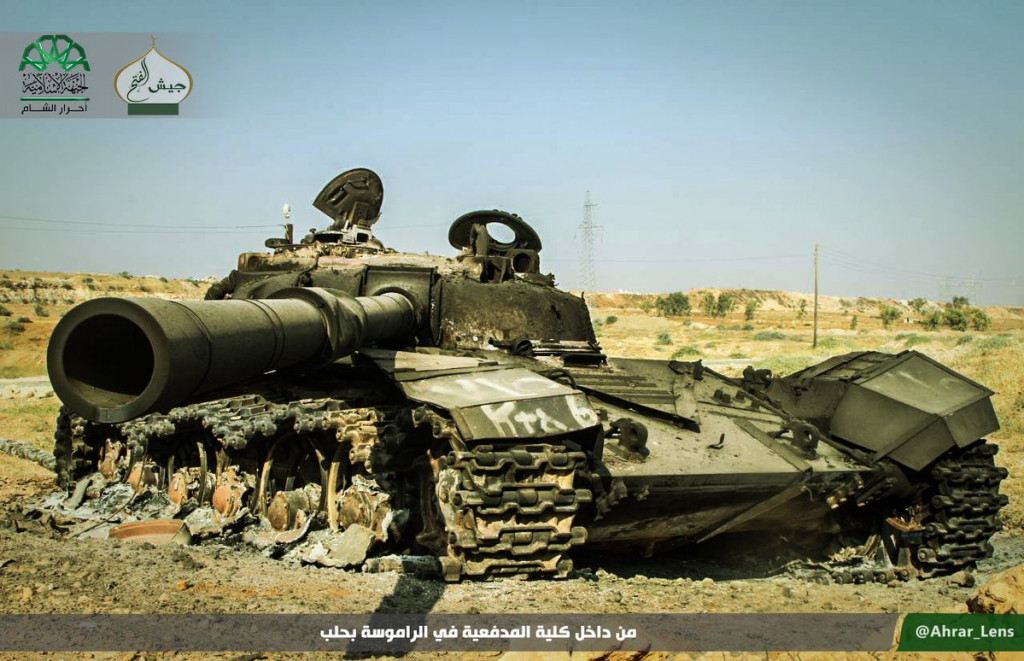
The burned tank which could be seen at the picture which provides the look from the 1070 Apartment Project
A drone look at the Ramouseh Artillery Base from the area of the Ramouseh garages (roughly):
It’s important to note that there are no high buildigns in the Ramouseh industrial district and the district itself does not overlook the Ramouseh Artillery Academy. So, fighters there cannot participate actively in the events in the Ramouseh Artillery Academy.
A look from the militant-held neighborhood of al-Ameria:
Buildings near the Ramouseh junction are located in a lowland. Thus, positions in al-Ameria allow to overlook the road, the nearby buildings, the road’s ramps.
A look from the housetop in al-Ameria (the picture allows to see the revetment):
August 6, 2016, the aviation college. There was a common military chaos in the area.
While some troops were combating enemy drones
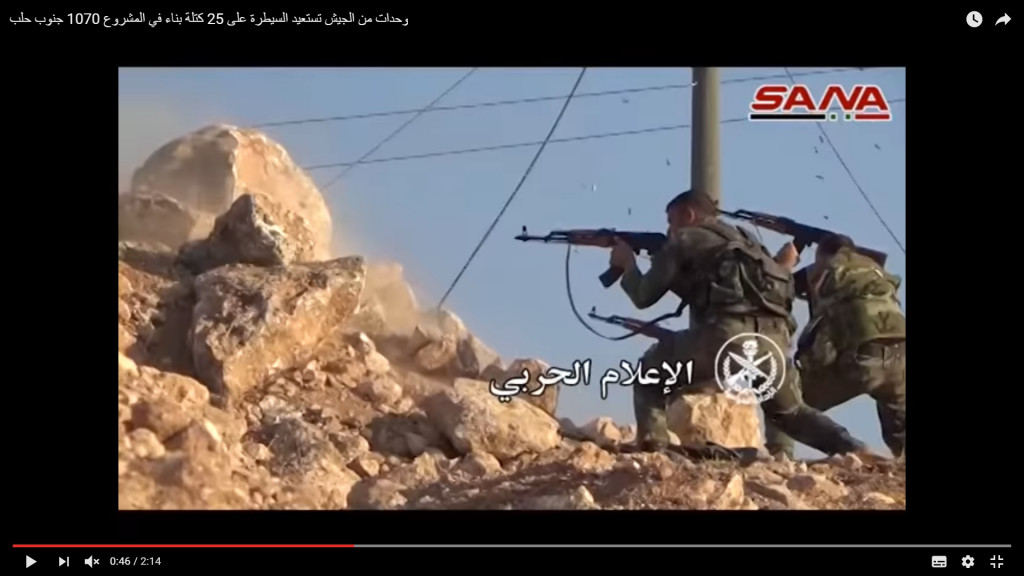
artillery units and warplanes were targeting the artillery college and the nearby armament college
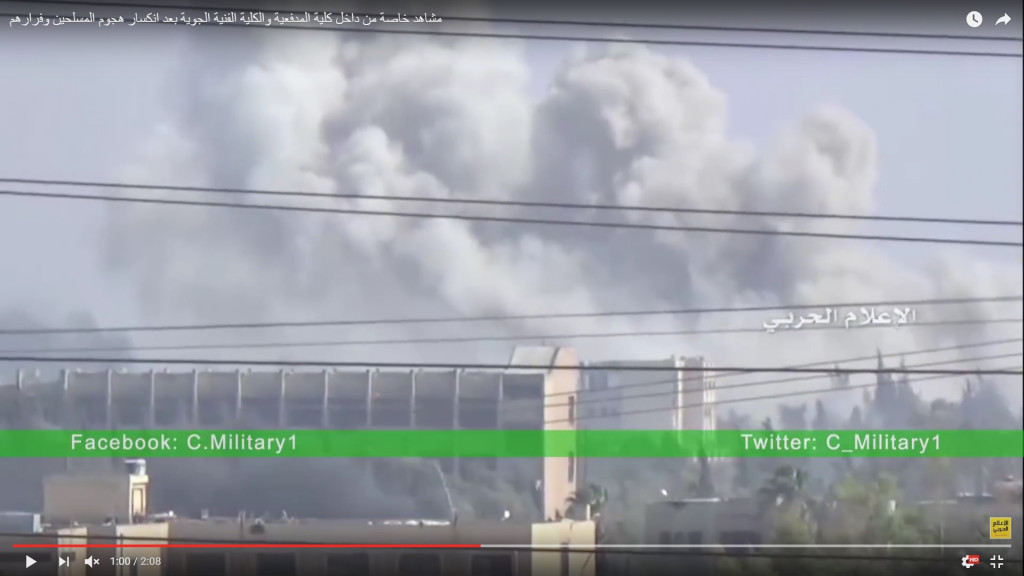
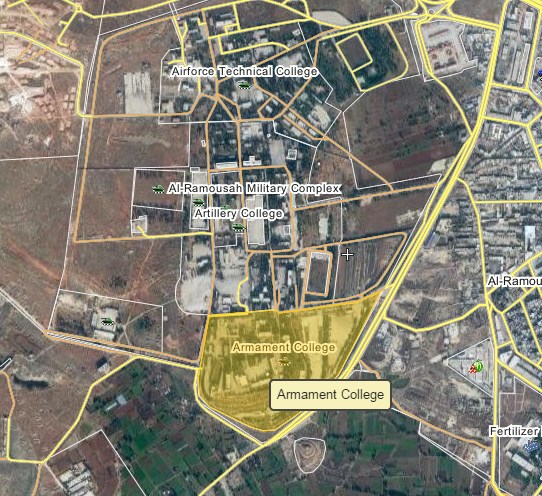
Meanwhile, the situation is calm near the shed hidding a warplane and a helicopter
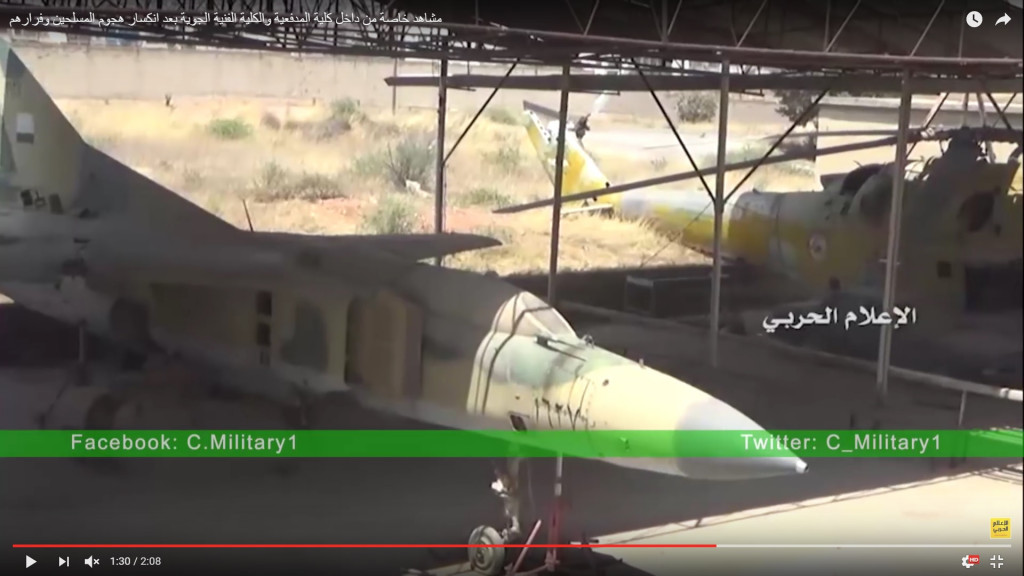
the mock airplane
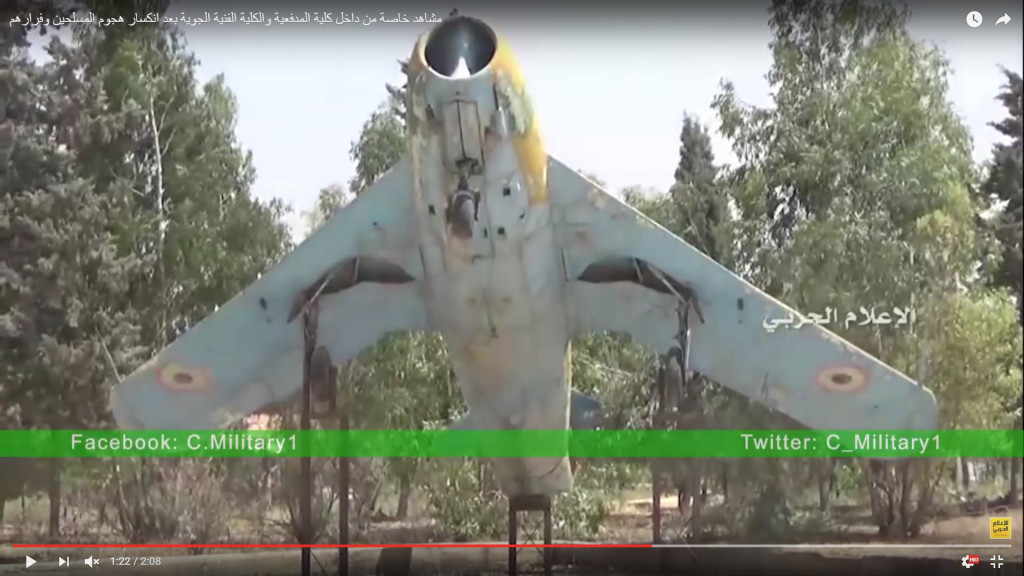
The situation in the area of the depot is also calm. Troops are evacuating goods from the depot. You could see a truck and a little part of the yellow building.

Two soldiers, the truck and a white minivan are near the depot. The minivan will be involved in actions in the area soon.
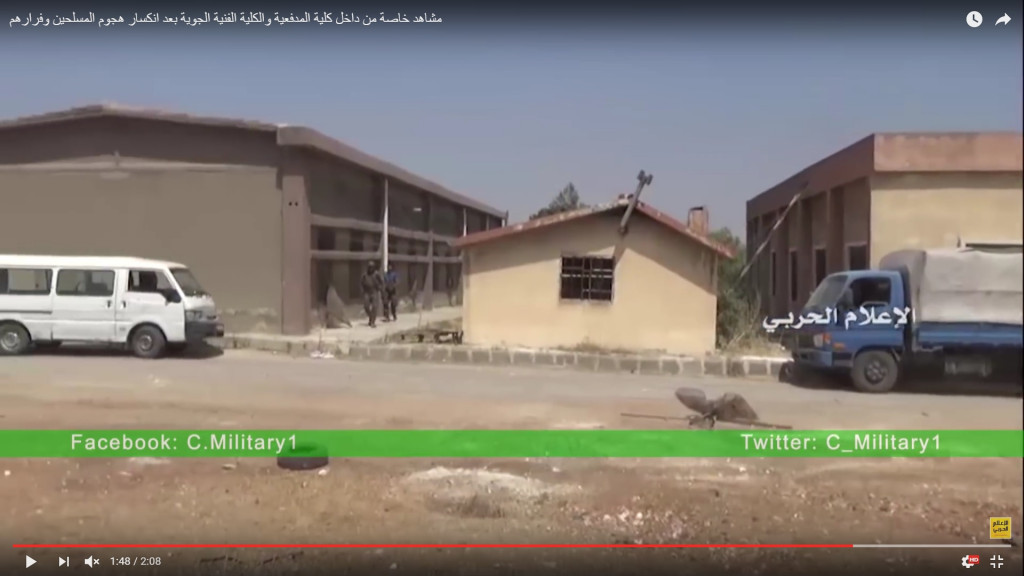
On August 6, “touring companies” of operators of anti-tank missile systems arrived al-Ameria (mostly with Fagot/Konkurs missiles).
A group of soldiers relaxing near the wall became the target of militants.
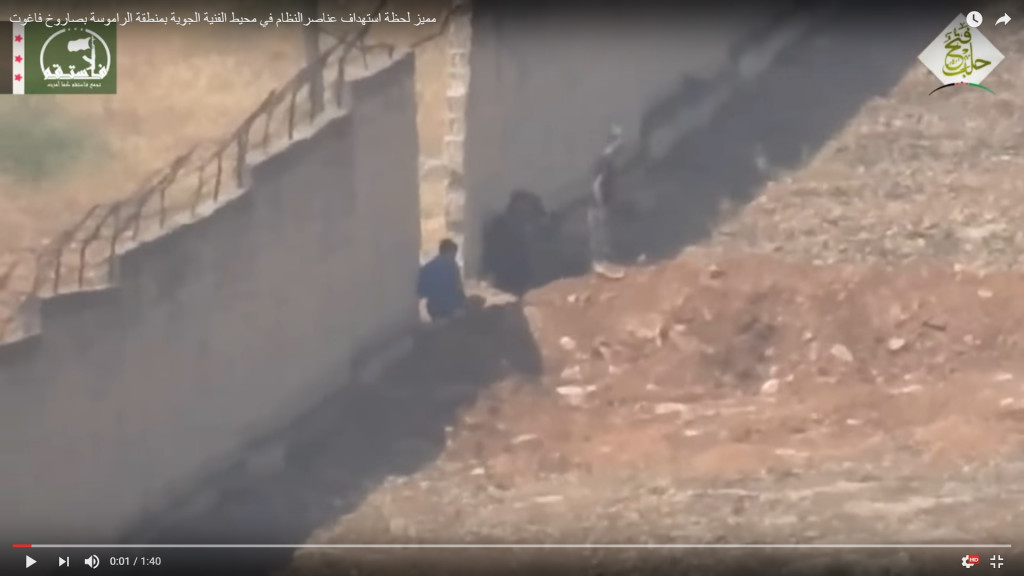
The first missile launch
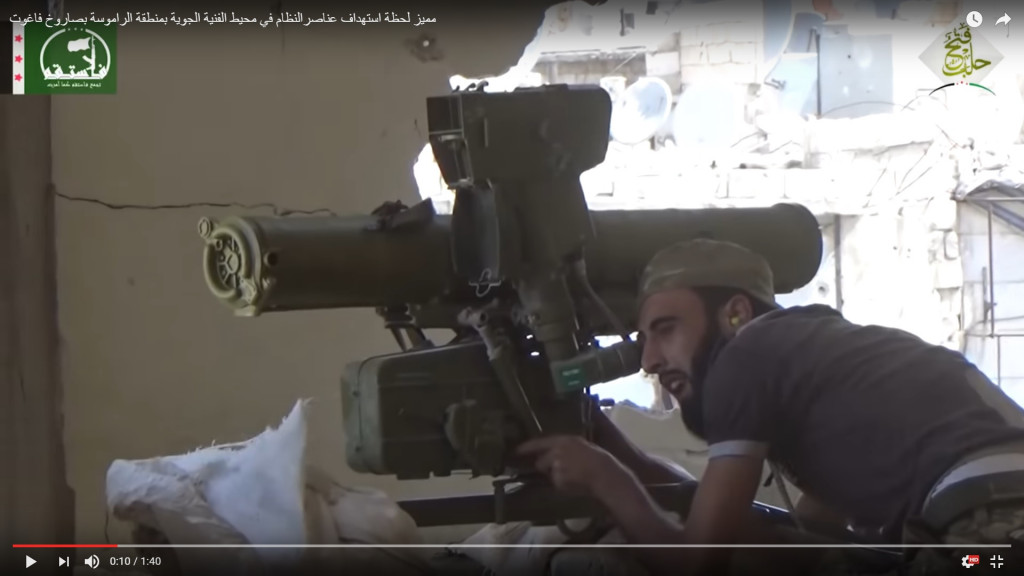
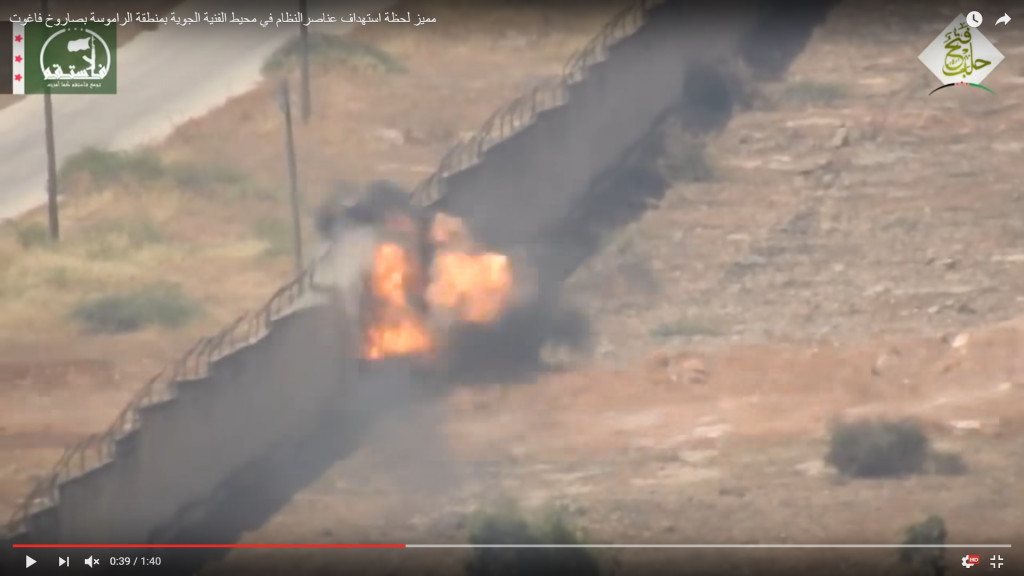
While the anti-tank missile crew was preparing a strike, some members of the group left the area. So, only two were hit.
The white minivan arrived the scene to evacuate troops. According to the video, one soldier was killed and another one injured.
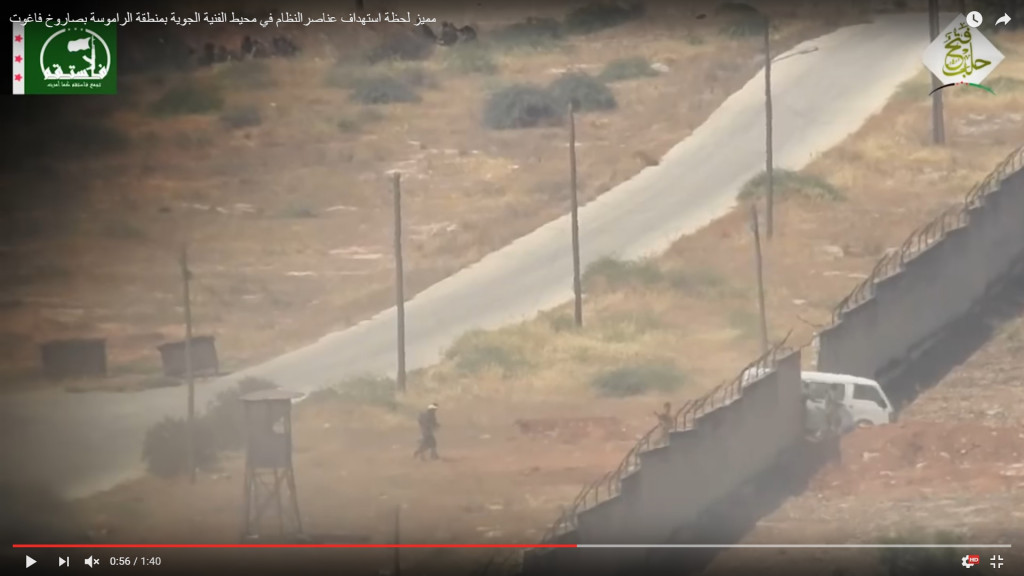
The white minivan leaves the area.
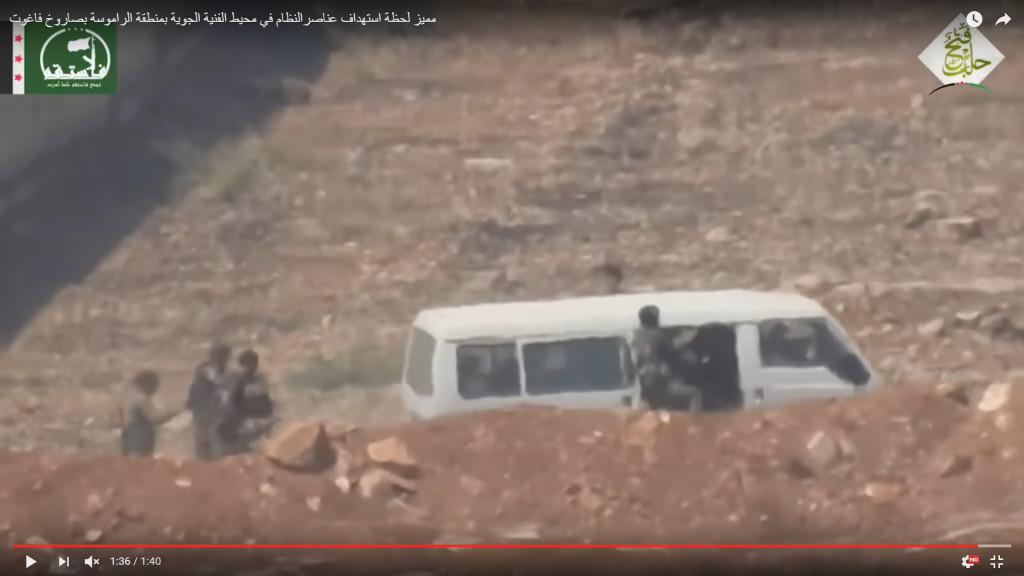
It’s interesting while the gunner-director desited to launch the missile against the group of soldiers near the wall while there were lots of soldiers at a rampart. It was clearly seen when the white minivan arrived the scene (in the upper-left corner of the picture). Maybe the militants had wanted to check the reaction of soldiers to a missile launch.
Probably, there was no recation to the strike. So, the militants launched another missile.
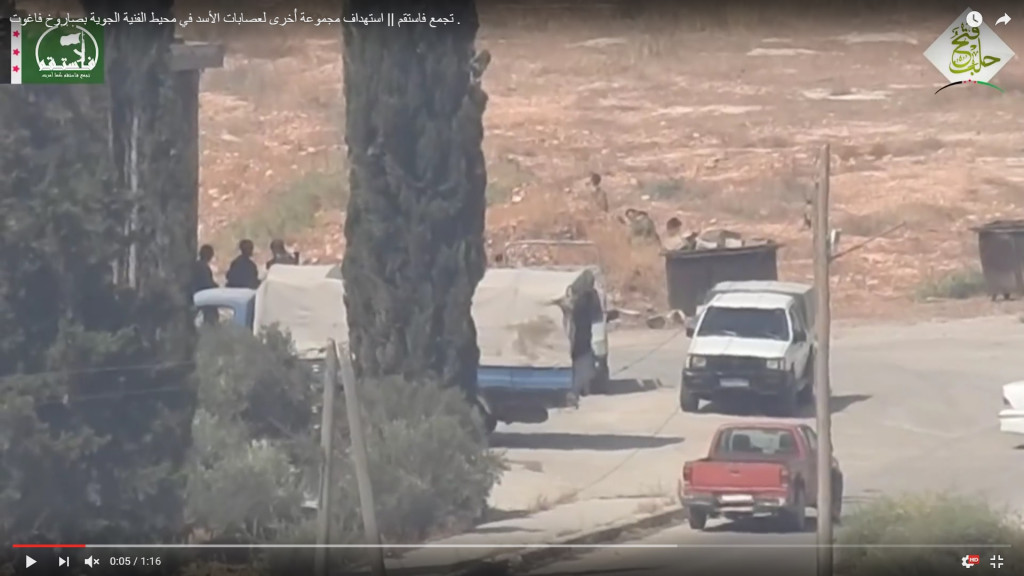
There were lots of targets: 5 vehicles, a group of soldiers on the steps, a group of soldiers at the rampart. What if there was munition in the blue truck? But the militant crew had own thoughts on the issue.


It looks that the missile was launched against a trash can, but the gunner-director missed. However, at least 2 soldiers were targeted, most likely, injured. They were evacuated with the soldier injured in the previous missile launch. A whitecar and the blue truck left the scene. Two pickups remained there.
The air power played a key role in the area. The artillery college has been a target for airstrikes since it was captured by militants.
An air strike on the artillery college on August 8.
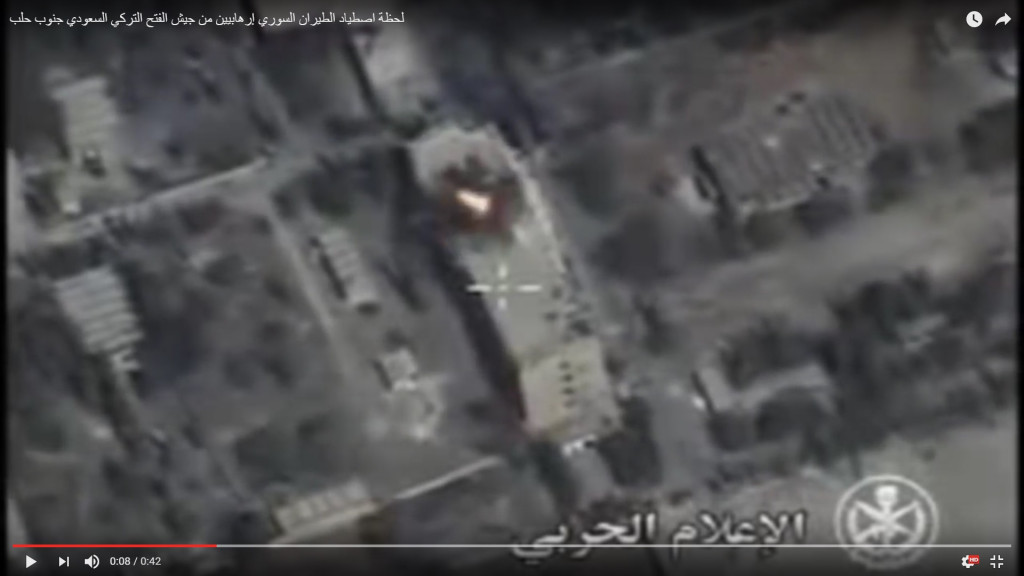
A group of militants near the artillery college:
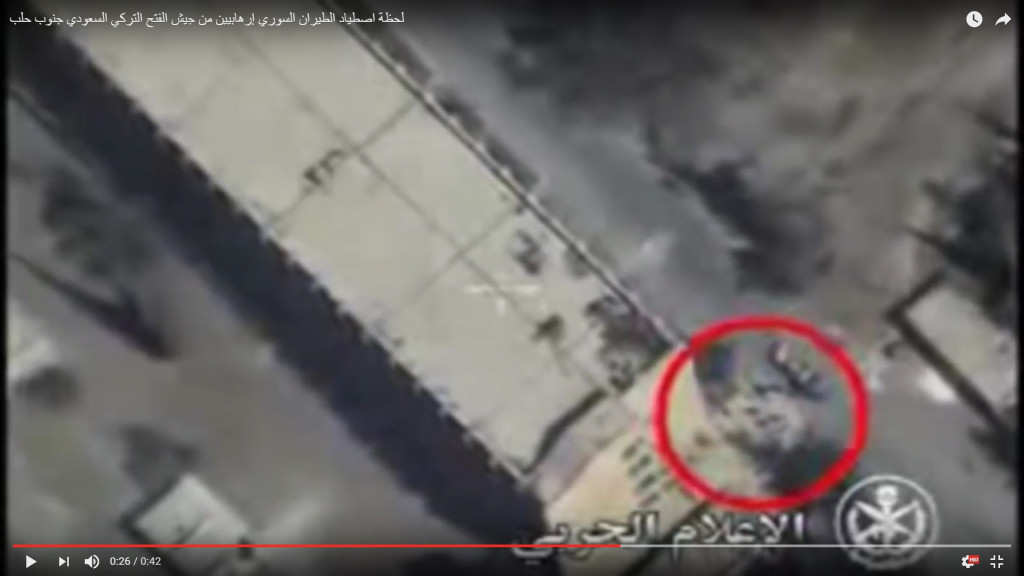
An air strike hit the group
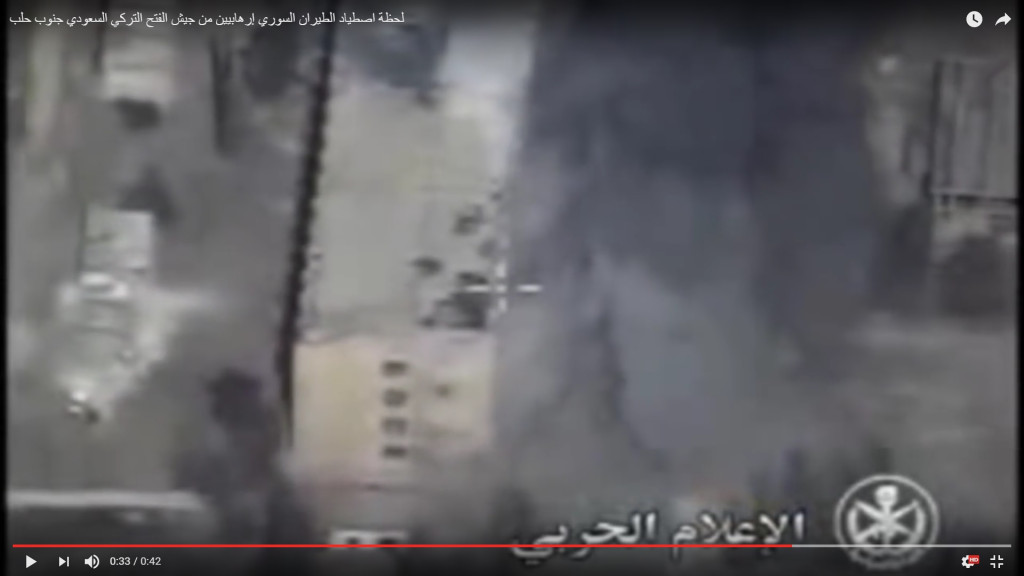
Then, there were a number of developments which were barely covered by media. On August 8, Maj. Gen. Zaid Saleh replaced Maj. Gen. Adib Mohamad as head of Aleppo Security Committee. The UN claimed that a humanitarian pause was needed to restore water supplies and electricity. On August 12, units of Liwa al-Quds (a Sunni Palestinian pro-government group) started to arrive western Aleppo to reinforce government forces in the area. On August 14, a deputy defense minister of Syria visited the area. Accidentally, a large-scale government advance was planned at thesame day. RT and ANNA News crews also arrived the area to film the advance.
As a result, government forces seized 25 buildings in the 1070 Apartment Project but failed to retake the artillery college.
Let’s look at the cource of the advance in the Ramouseh Artillery Academy area.
Preliminary artillery and air strikes:
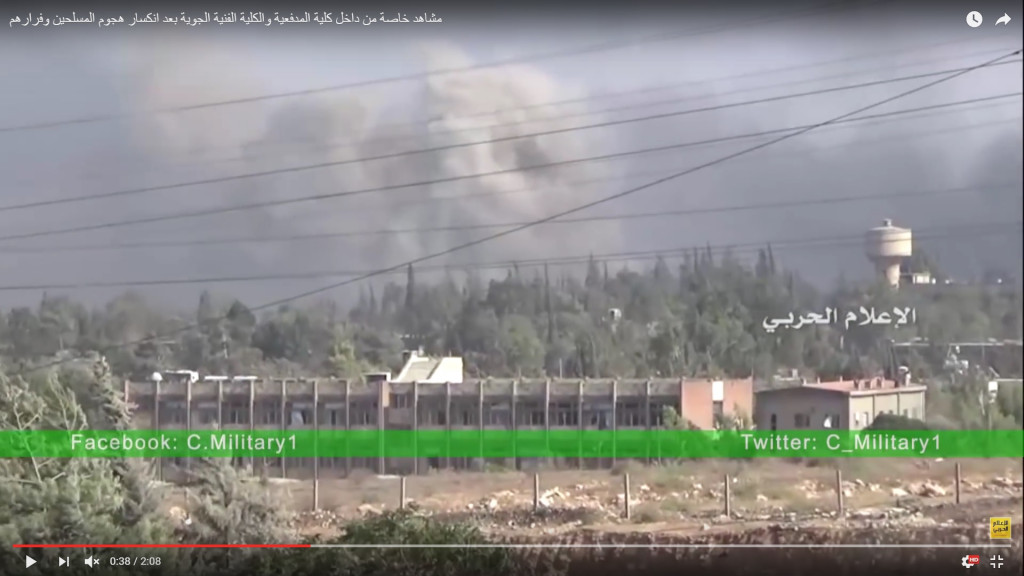
Deployed reinforcements (two T-55 battle tanks):
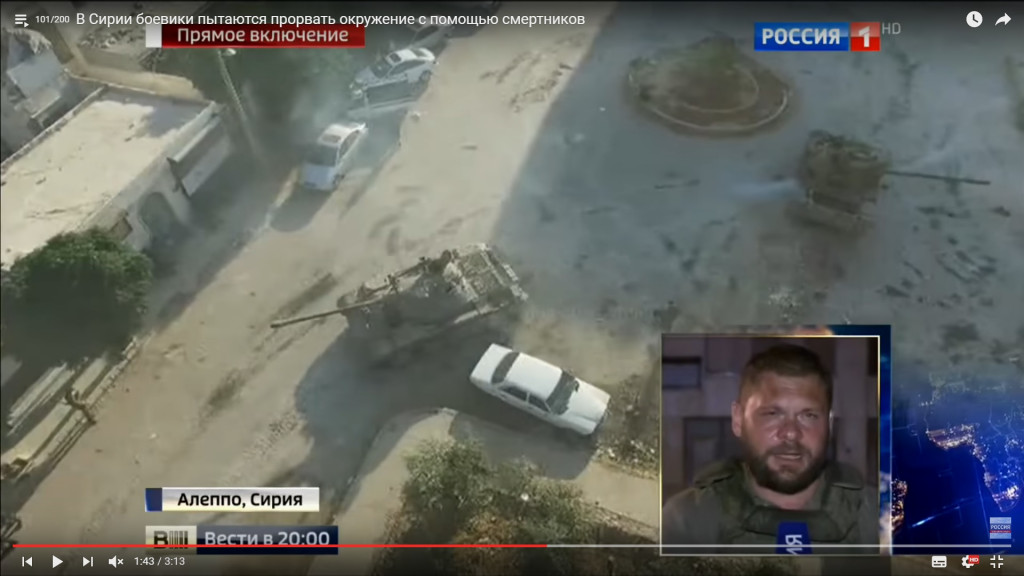
BMP-2 infantry fighting vehicles were used to transport troops:
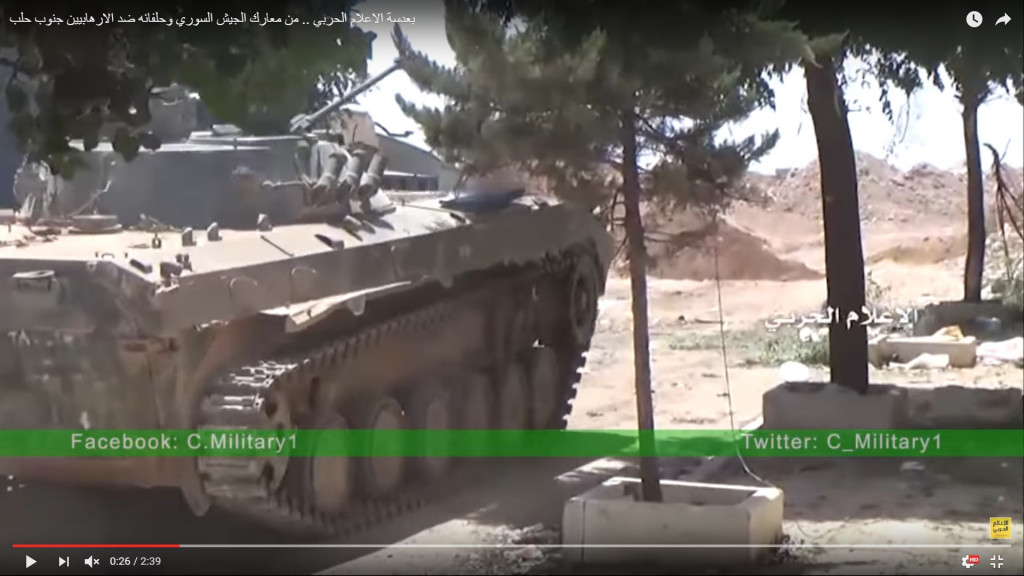
another armoured vehicle
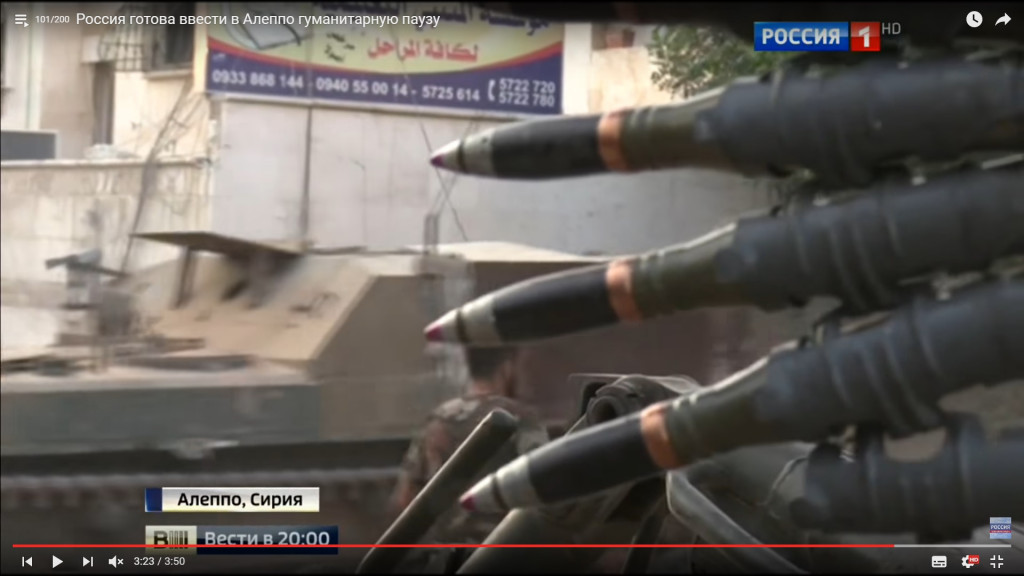
a vehicle equipped with a machinge gun fires at militants from the road
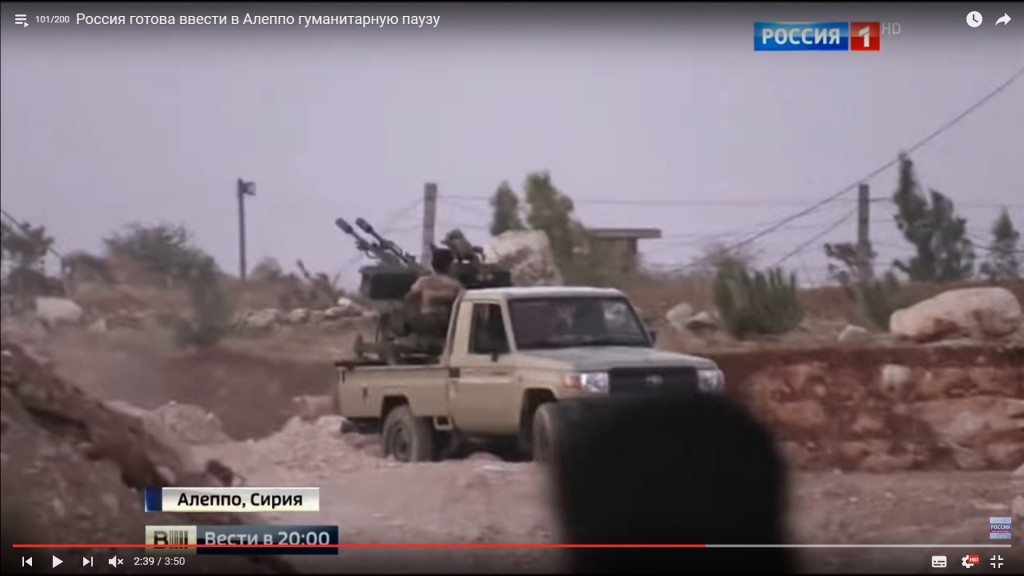
A battle tank shells the yellow building and the aviation college
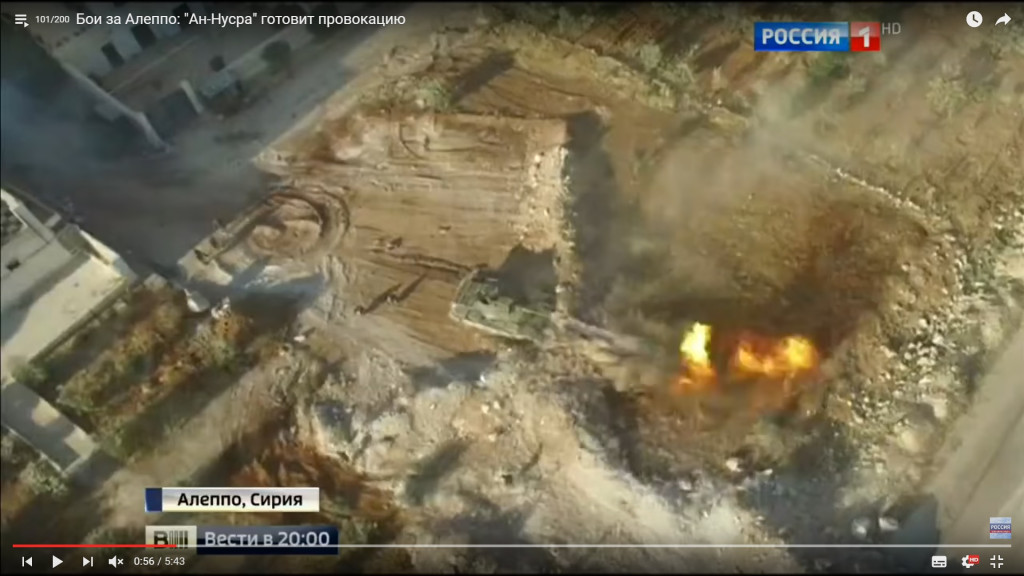
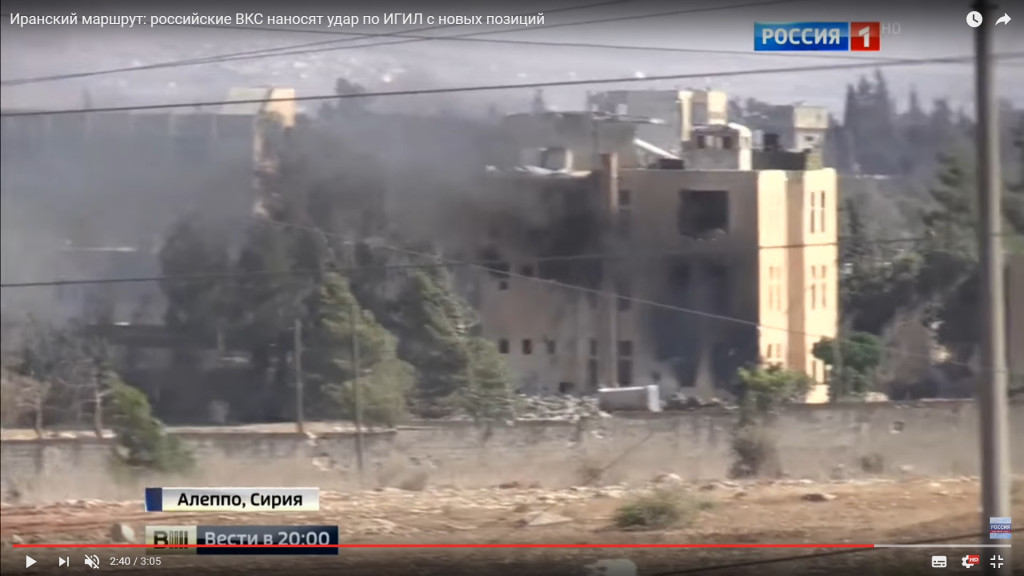

But all these efforts were not enough…
Troops reached the road separating the Ramouseh Artillery Academy area and al-Ameria
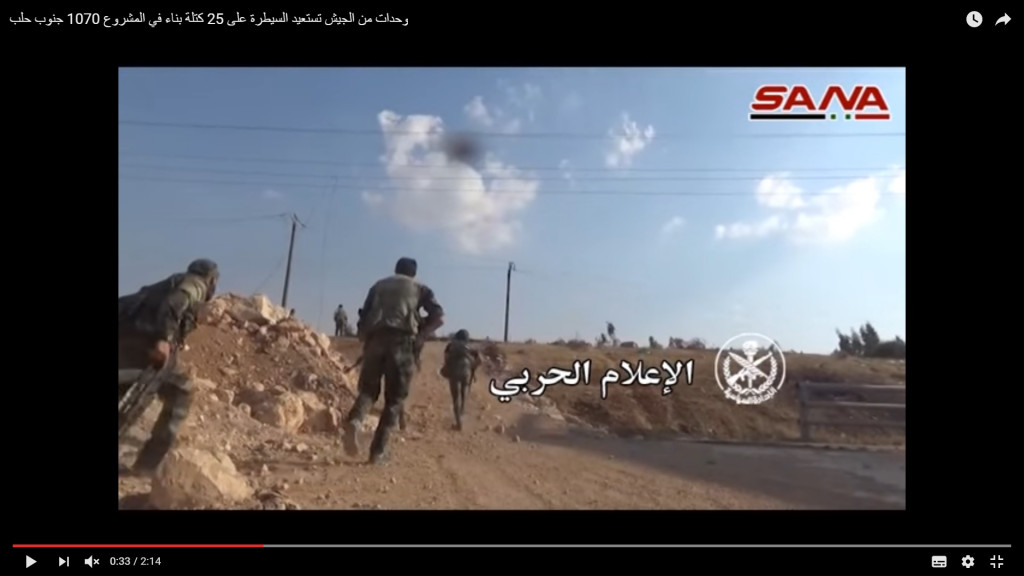
but were engaged in an intense firefight with the enemy’s drones and birds…
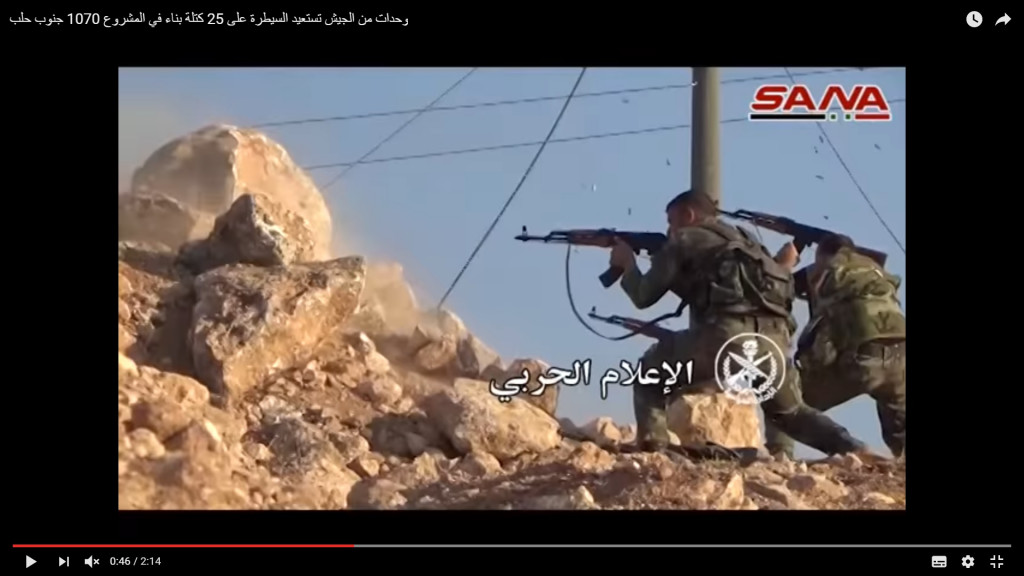
As a result no gains were made. ANNA News journalists released a report about “a success in the 1070 Apartment Project”. RT released a video from the filmed drone footage and reported about clashes in the area.
The next real attempt to advance on militant positions in the Ramouseh Artillery Academy area took place on August 17.
August 17 (early morning)
Government troops and an armoured vehicle reached the revetment. Then, the vehicle with a group of troops moved to the right flank
A T-55 battle tank was deployed to support the advancing troops
and another T-55 deployed to operate in the area
Both tanks started to shell the yellow building and the aviation college
Supported by the tanks’s fire, troops reached a gap in the wall near the depot.
A group of troops advanced further facing no resistance from militants
A BMP-2 infantry fighting vehicle reached the road but its driver faced some problems with choosing a right direction
The BMP-2’s driver solved his problems
Meanwhile, troops were attempting to reach the depot
The situation was still calm and a soldier checked the depot
More troops were arriving the area. Some of them decided to make few shots in the direction of Ramouseh to allow journalists to make a nice video
The picture allows to see a shot at the wall – this is result of Rambo-style firing.
This is why an infantry commander ordered to stop this.
The BMP-2 also reached the area while troops were seizing more buildings near the dining facility.
A group of soliders were firing in the sky, celebrating the “success”.
The aviation college was the next target.
More troops were moving to the aviation college.
Walls inside the aviation college were full of “rock painting” by “modereate opposition” members. The building had been looted.
After entering the aviation college, government troops advanced deeper into the Ramouseh Artillery Academy area.
Something was burning
The supporting forces had nothing to do whie all was going ok.
The lost of the depot, the dining facility and the nearby buildings were not critical for militants. The aviation college building was much more important because it allowed to get a fire control of the supply line used by militants in the area. Furthermore, the rapidly advancing Syrian army could reach the artillery college which overlooks the whole complex.
The militants defense strategy was:
- To use observation parties at a forward line to monitor the situation and to avoid casualties in case of artillery and air strikes;
- In case of the government advance, militant observation parties just retreat;
- When government troops advance deeper into the complex and lost a fire support from the government-held area, militant units deploy reinforcements and conduct flank attacks against government troops.
Meanwhile, armored vehicles were deploying reinforcements to government troops
and the militant ATGM crew responded with another missile from al-Ameria.
Despite an eye-catching explosion, the missile missed and the vehicle left the area. Casualties among government troops were unclear.
At the same time, Jabhat al-Fatah units launch a mortar shelling and a counter-attack aganist government forces. One group of militants attacked from the direction of the yellow house. Another one seized buildings near the aviation college.
Panicking government troops left the aviation college building.
The picture provides a militant look from the recaptured aviation college
More military strikes hit the yellow building area
General Deeb Bizzi, chief of the Technical Base, was killed in the failed offensive. Probably, this was his car.
A scheme of the government advance:
In general, all next government advances followed this scheme:
- Tanks shell militant positions from the road;
- Troops advance to the northern corner of the complex and seize the depot;
- Armored vehicles bring reinforcements;
- Troops attempt to seize more buildings.
A doubtful incident took place on August 17 (or August 18). Militants attacked government troops in the depot and pushed government troops to retreat (or the Syrian military decided to withdraw fighters from there). Retreating troops came under a mashine-gun fire on the road to Hamadaniyah. The retreated was turned into a headlong flight.
Some troops attempted to reach another side of the revetment to hinde from shots from the yellow building
There was almost no retaliation fire from the fleeing soldiers. There were 16 bodies on the road. Only 2 were turned in the direction of the yellow building.
Battle tanks subdued the militant fire from the yellow building and an armoured vehicle arrived the scene to evacuate injured people.
This could be seen here:
This picture shows retreating government forces as well as bodies:
Red circles also mark soldiers. Most likely, they used the wall as the cover during the militant shelling.
4 battle tanks provide a fire cover. A group of soldiers reached a safe zone and restes near the revetment.
The rest of government troops and a vehicle are retreating. Traces of mortar shelling are seen on the road.
This was not the first or the biggest failure of governmnent forces in western Aleppo. But the problem was that the bodies of dead servicemen were not evacuated from the “dirty military road”. The bodies remained in the area until August 30. On August 27, pro-militant media outlets even released a video showing the bodies.
Most likely, the militant video became the main reason of the evacuation of the bodies from the area. There were many versions why this became possible: rotation of government forces in western Aleppo, a carelessness of the local command staff, etc. Or maybe Syrian servicemen were planning to evacuate bodies of their friends later when the nearby area was liberated from militants.
On August 19, government forces made another attemtpt to retake the Ramouseh Artillery Base area from Jabhat al-Fatah militants. The government military grouping deployed to for the operation received reinforcements.
For example, the Syrian military deployed a T-72 battle tank and more troops.
The advance started in the morning. Initially, battle tanks shelled the yellow building and the aviation college.
Infantry moved to the Ramouseh Artillery Base area.

Click to see the full-size image
They moved to a water tower and turned to the wall which we saw in previous pcitures.
A T-55 moved in the direction of the water station and hid in the nearby parking amd became a target of our well-known ATGM crew.
The picture also allows to see a notable number of soldiers “resting” in the area and the tank crew left the battle tank.
A direct hit:

Click to see the full-size image
Russian media filmed the burning tank:
Pro-militant sources released own version of the video:
Militants started to shell the road separating al-Ameria and the Ramouseh Artillery Academy area:
Militants use foreign-supplied mortar shells with Soviet fuzes and ignition cartridges
Militant mortar positions were located in the 1070 Apartment Proejct and in the artillery college. Now mortar shells hit the road much closer to government troops and a vehicle armed with a machine gun (a smoke cloud left of the vehicle). As a result of the shelling, the vehicle was deactivated and next morning there was a big oil stain on the road.
The mortar shelling continued. The tank left the road, troops hid from the shelling.
Meanwhile, a group of soldiers decided to relax near the fense. This is the same group which we had seend during the anti-tank guided missile launch against the T-55 tank.
The militant ATGM crew ruined the peaceful landscape:
The missile missed, but some soldiers were injured.
A large group of soldiers retreated from the front using the ATGM launch as an explanation of the decision.
4 soldiers transported an injured friend to the rear.
One more strike (most likely another guided missile)… and the rest of the group retreated from the area.
Government forces made another offensive attempt in the afternoon.
They reached the wall… and decided that they need a rest.
The ATGM crew was ready.
A direct hit:
A drone filmed the result of the strike:
The second missile hit the retreating troops
This guy had some comments over the situation
Meanwhile, a battle tank reached the depot which was not defended by militants. The tank crew was more strong-willed or just less informed then its counterparts.
Some troops followed the tank.
A guy in the glasses informs an infantry commander that troops have to secure the depot and the dining facility.
But they both look like they know the result…
Militants launched shelling from two directions (from the yellow building and from the militant held area of the complex) and pushed government troops to retreat from the dining facility area.
Mortar shells hit the government-held area in Hamadaniyah
In turn government battle tanks opened fire at the yellow building and the aviation college
The white minivan and another car were also involved transporting injured and killed soldiers:
The situation was calm next few days. The Syrian military wroked to finish the ongoing regrouping of forces for the advance in the area. Liwa al-Quds units were the core of the newly formed striking force.
Meanwhile artillery units and warplanes were striking militant positions in the complex:





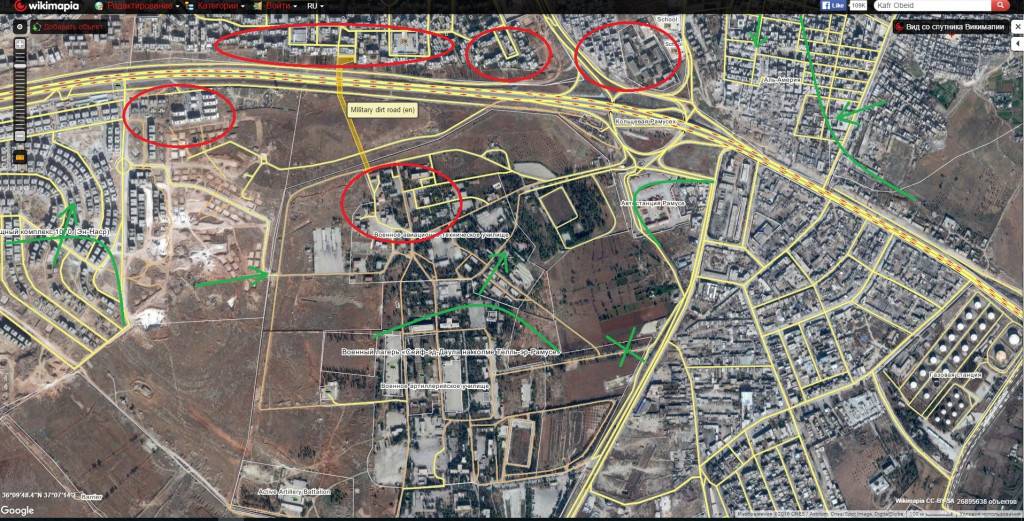

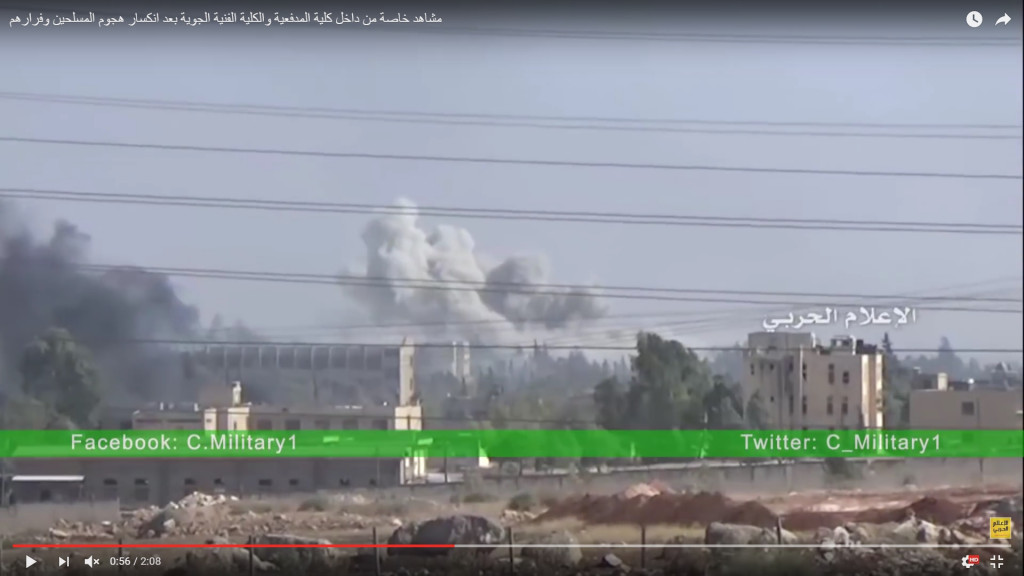
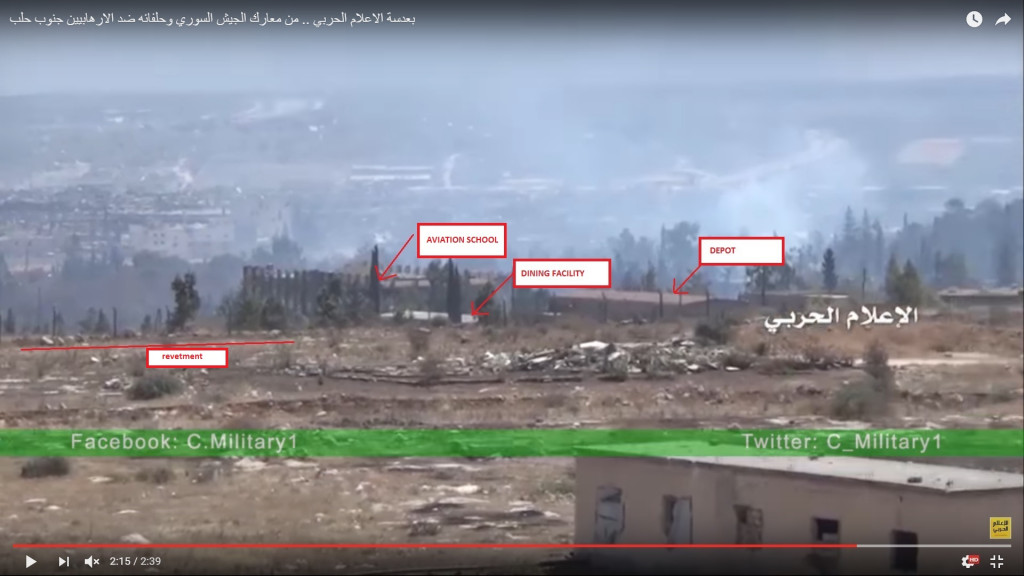
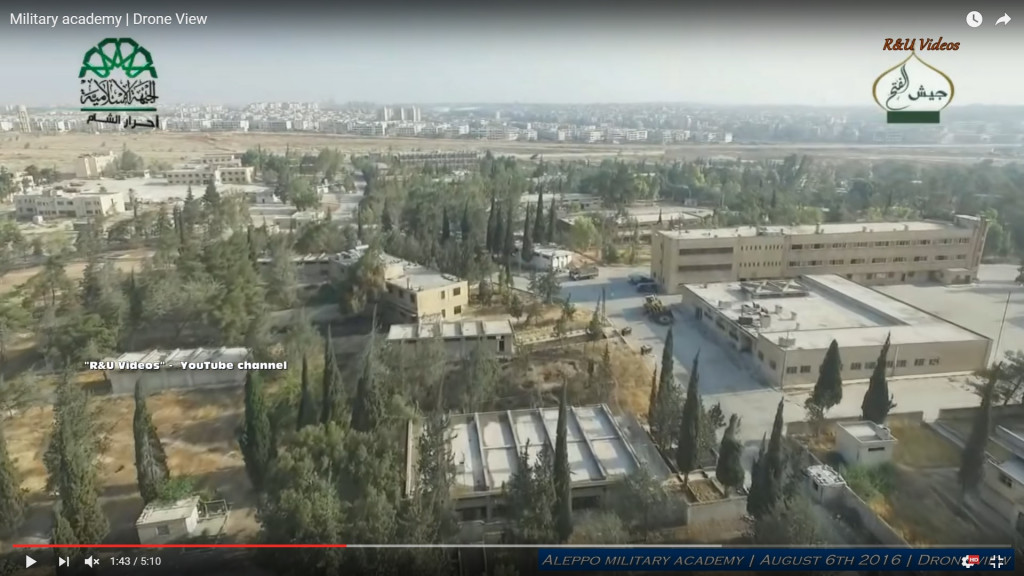
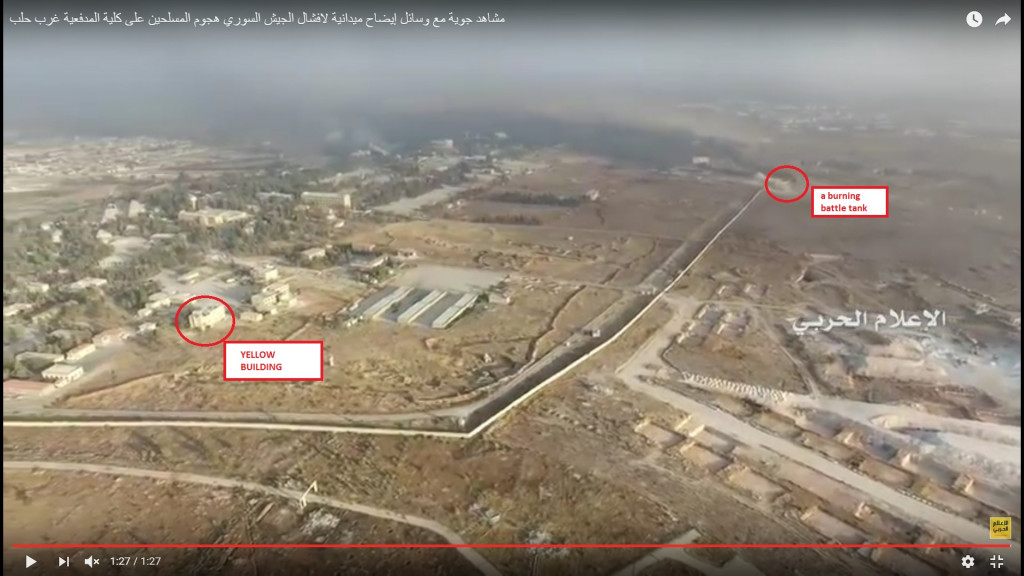
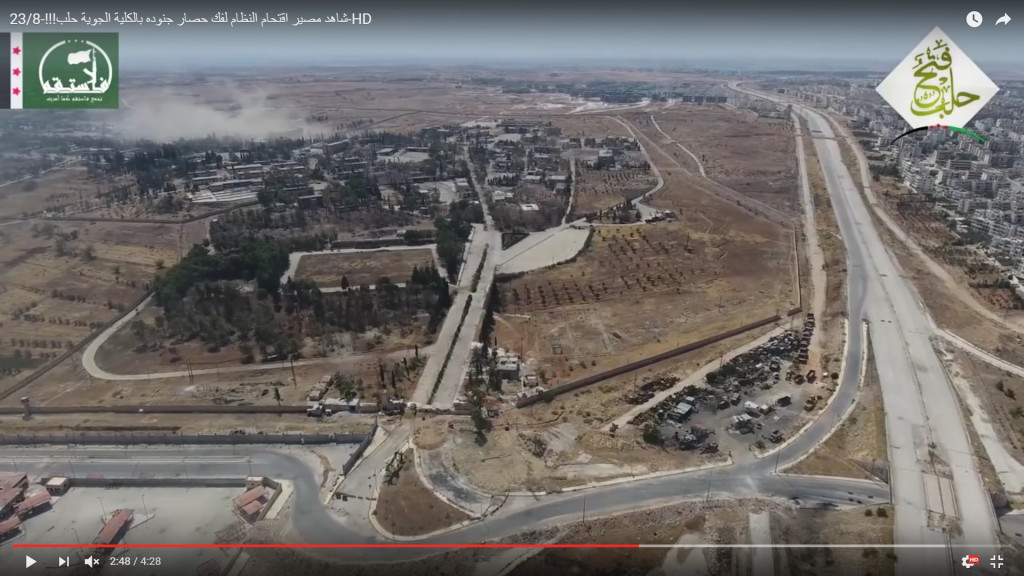
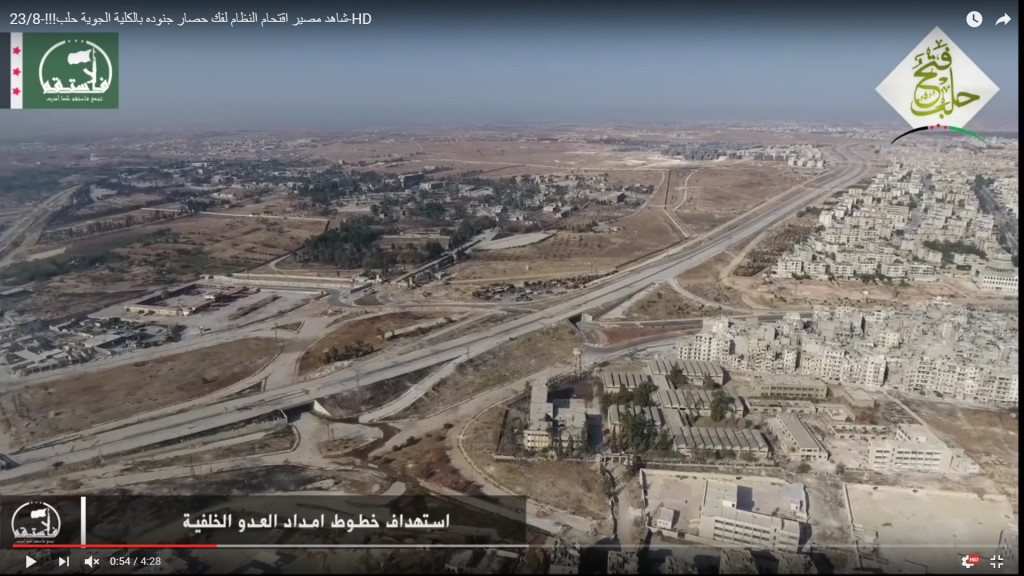
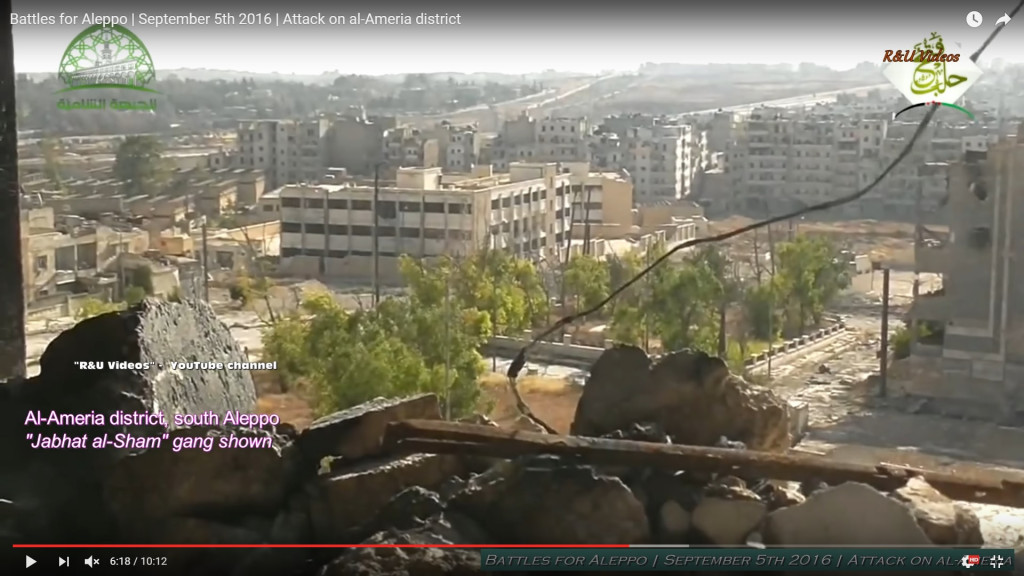
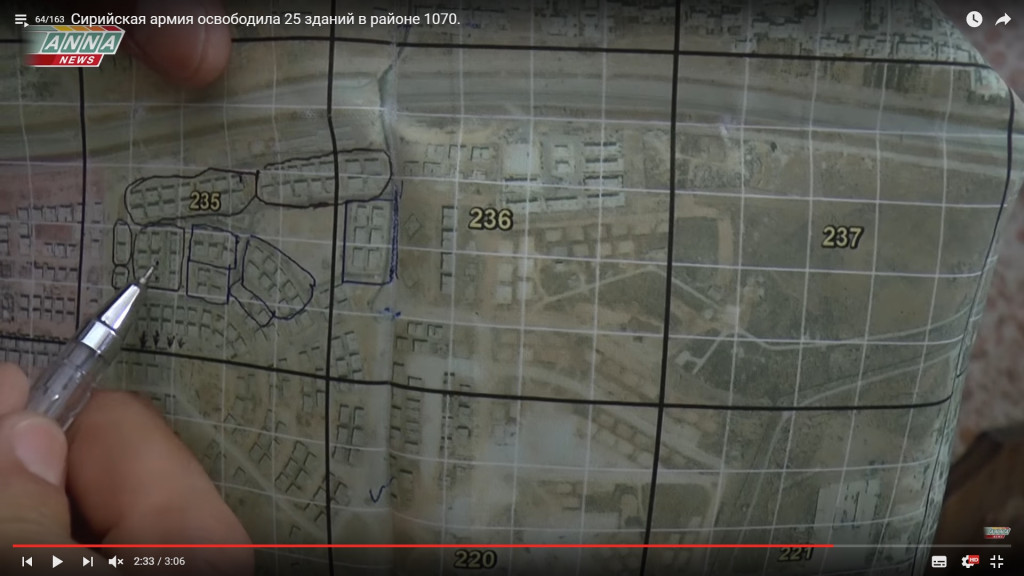
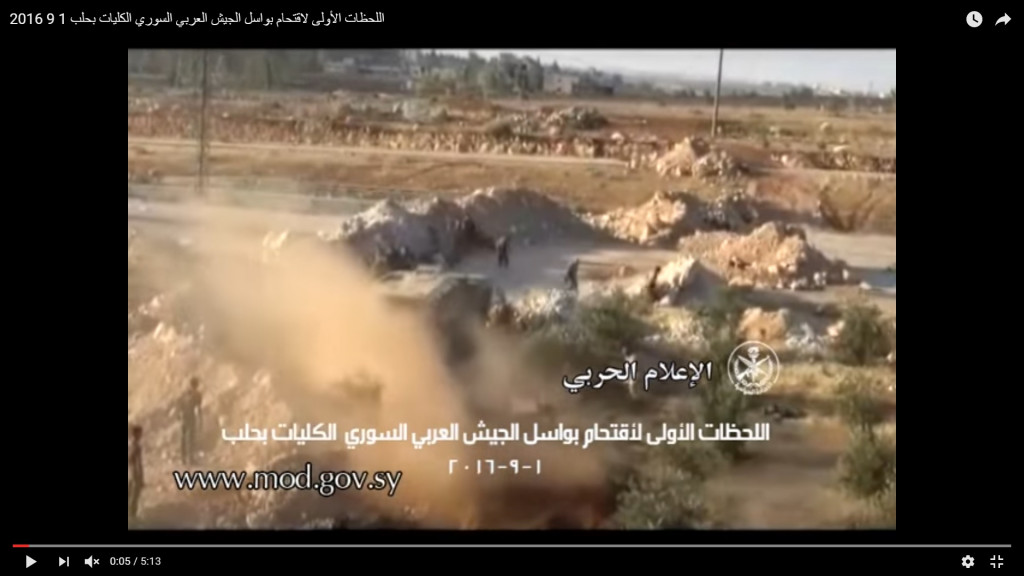
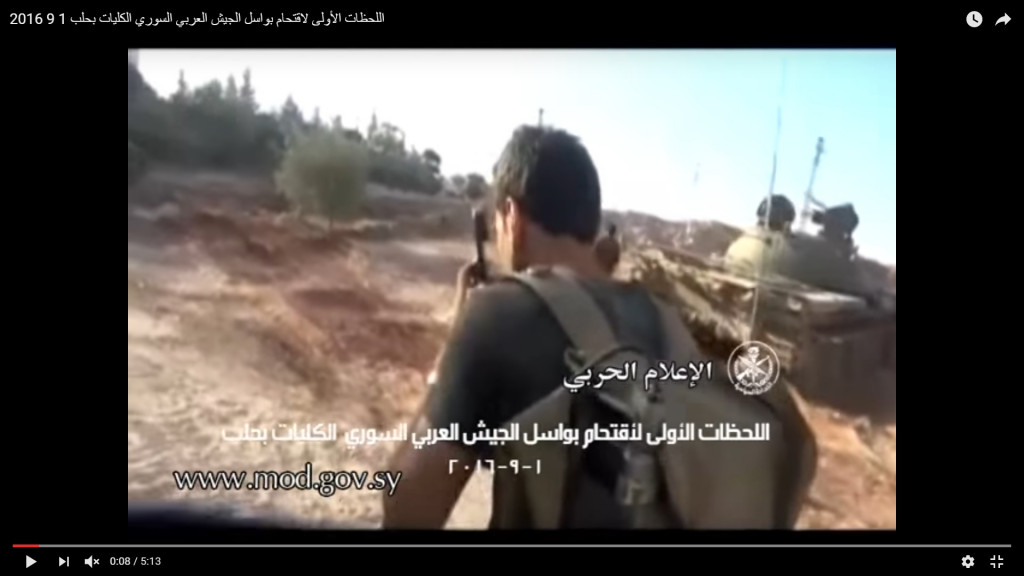
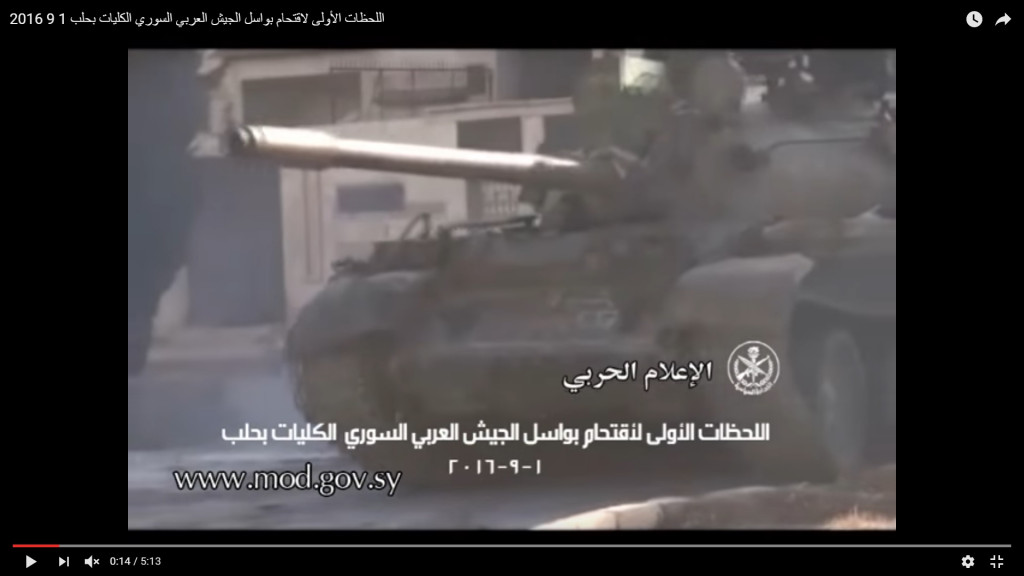
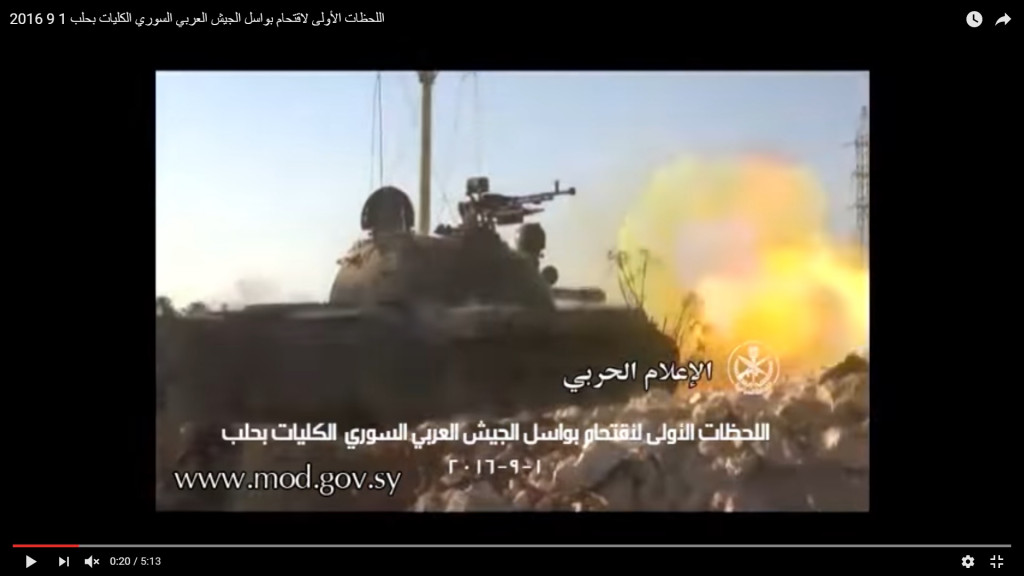
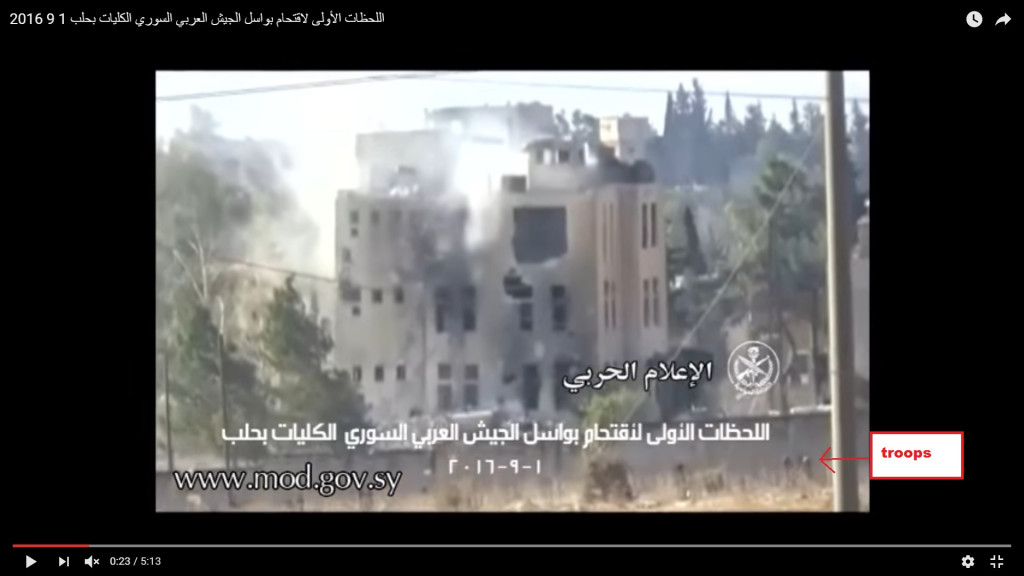
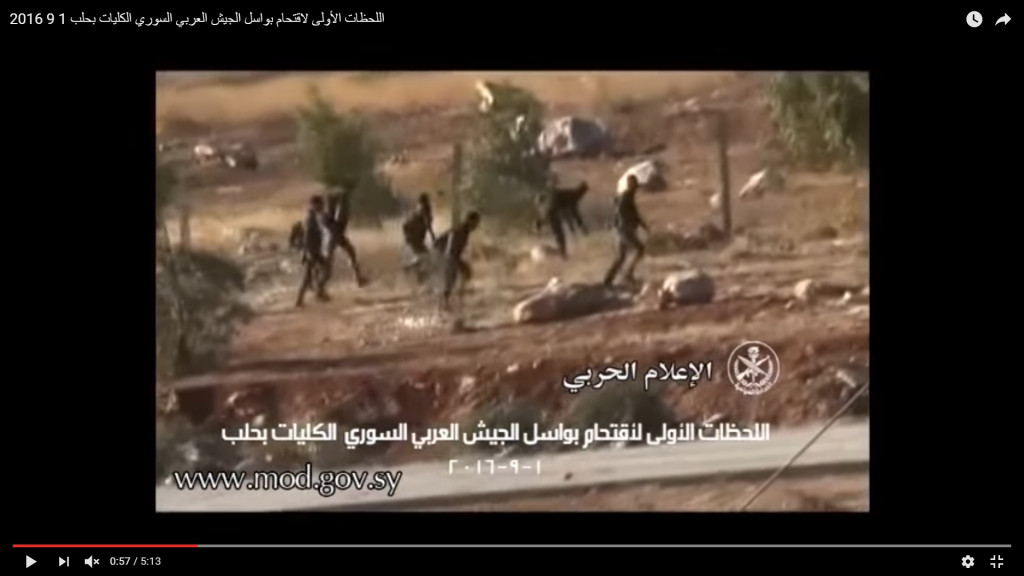
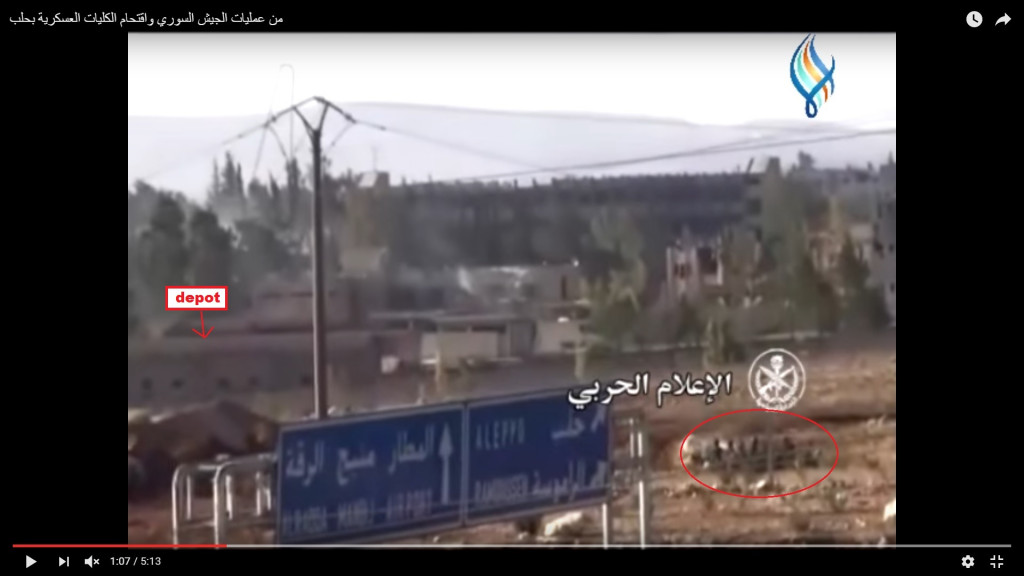
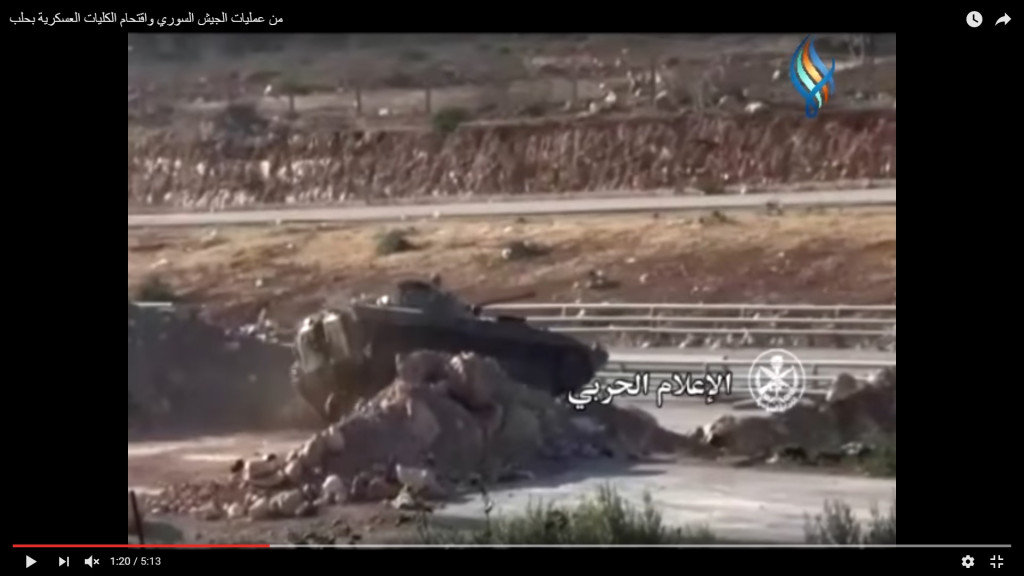
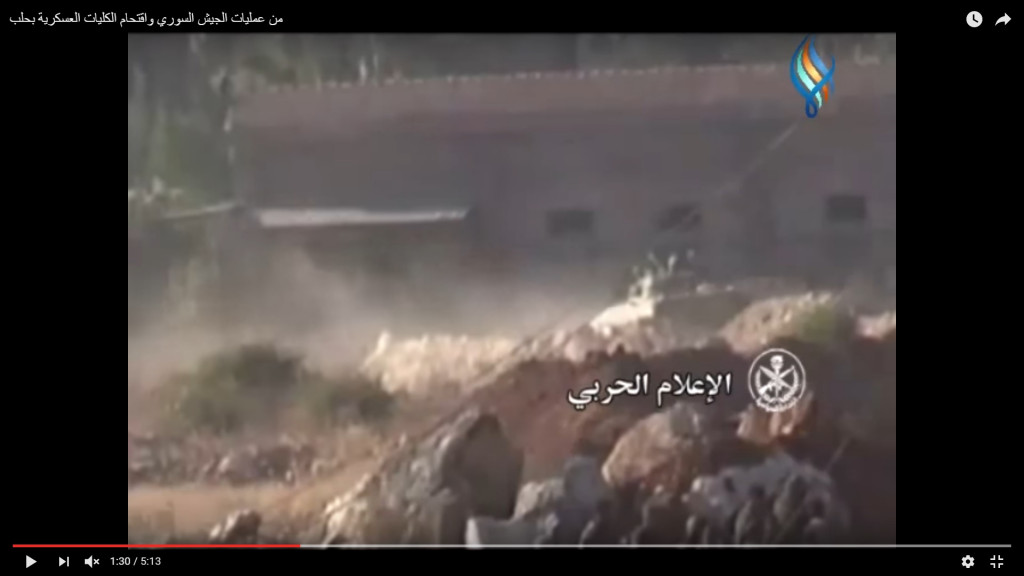
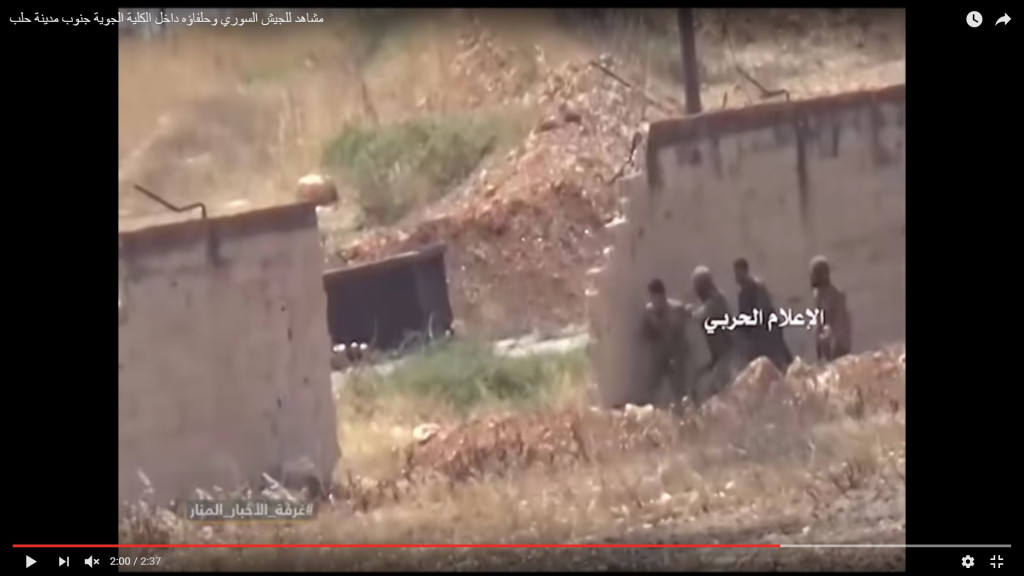
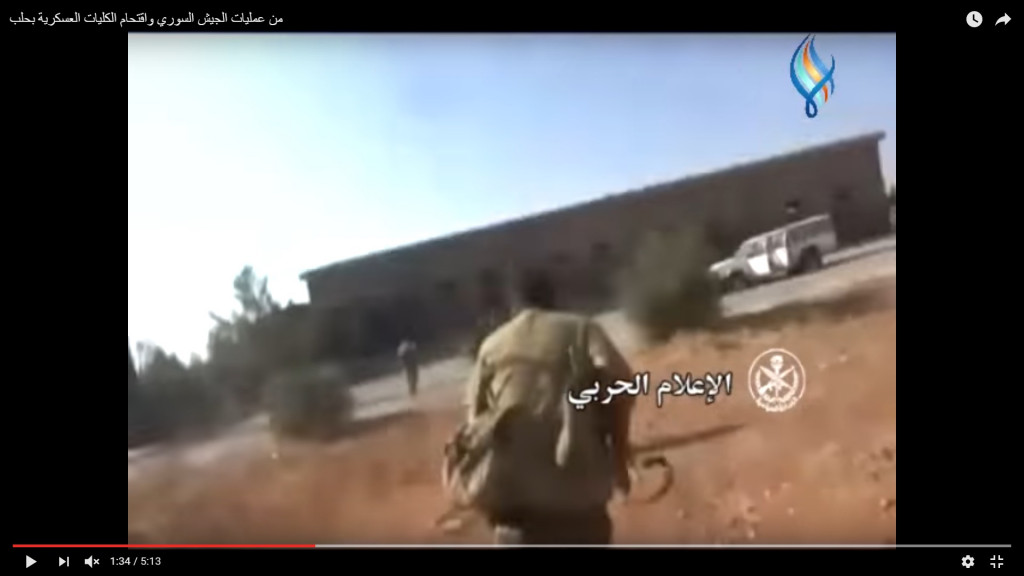












































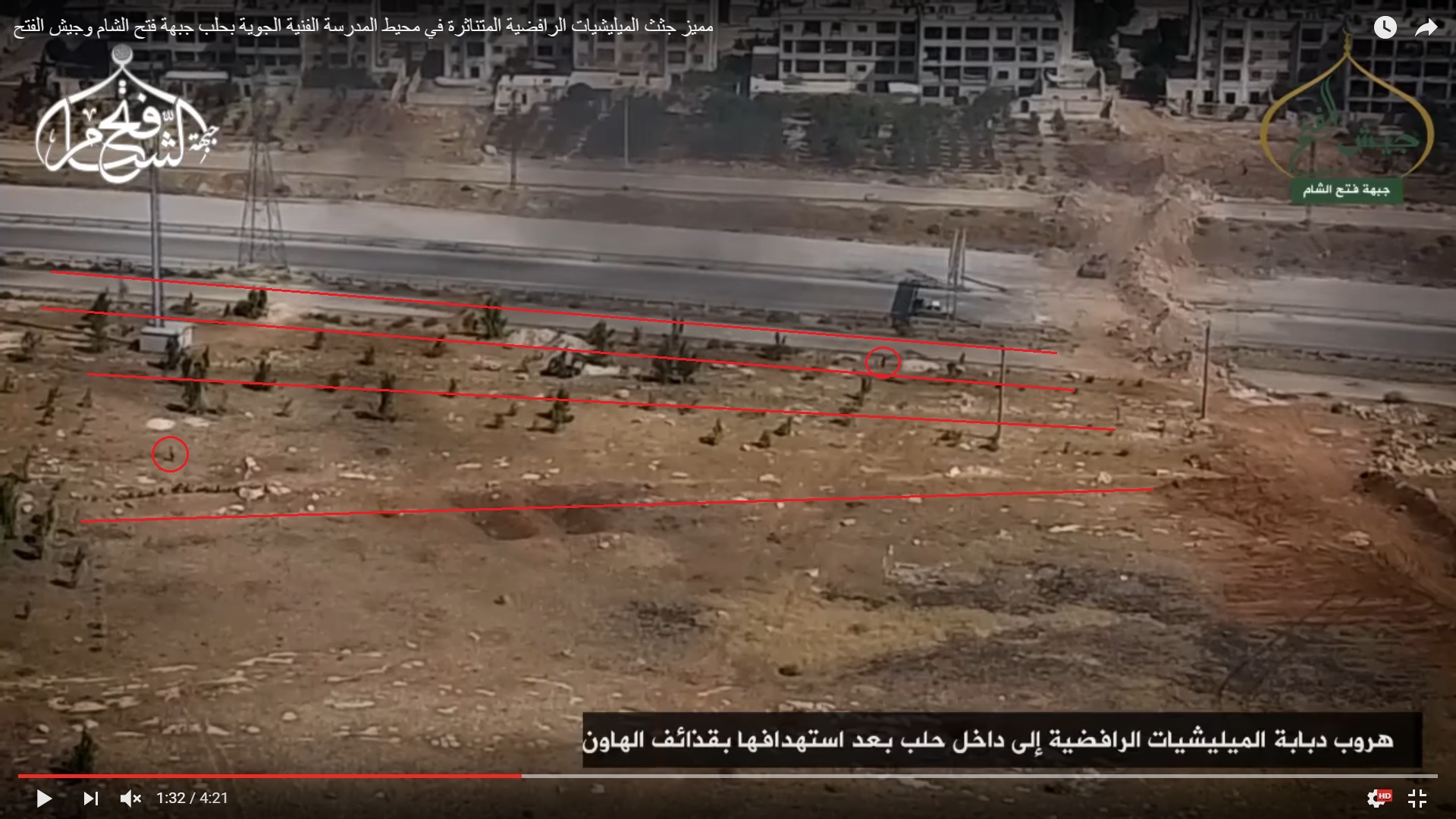




























wtf…
This is for crazy laughing.
For those who know russian. 5 parts here – http://lostarmour.info/articles/hroniki-muravinoy-tropy/
Nice article SF, and a lot of pix!!
This was a very difficult back and forth battle to retake the northern section of the base.
But in the end the Jihadist hopes of relieving E Aleppo where crushed
SAA has not the most motivated fighters it seems… i dont know why they dont knock down the whole complex day and night with artillery… useless to send infantry in….
Not enough batteries with plentiful ammo I think.
You over estimate the ability of arty to “flatten” an area of hard structures.
Even Stalingrad was not “leveled” after many months of bombardment.
Troops can still find protection and firing positions in the ruble.
Why destroy a perfectly good facility when a company of troops skilled in urban warfare could wink out the few opposition fighters causing the mayhem? It’s quite obvious that these poor fellahs weren’t up to the task but might of been the only troops available at the time. I’m surprised that they went into combat without smoke grenades to conceal their movements and block the vision of the ATGM gunners.
There for the grace of God be I , but the infantry training of the SAA soldiers must have been appalling.
Shia militias where also involved. SAA very much wanted to retake this base to stop Jihadist in relieving E Aleepo. The battle was difficult, but had to be fought.
For awhile the SAA was giving forced conscripts a week’s training before sending them out to the front lines. They also had and still have a woeful shortage of experienced NCO’s and officers. This rag-tag group that kept getting shot-up were most likely leaderless so did as most leaderless troops do and retreat if there’s nobody of higher rank around to tell them what to do.
Nice pics SouthFront!’ I agree with PZIVJ1943. It was a tough back n’ Fort battle. I wish the SAA found a way to steadily hold positions after capturing it to prevent unnecessary waste of manpower and resources.
They’re working on that. One reason for the lack of manpower is that Assad’s daddy changed up the command structure so a local commander had say where and when his troops could be deployed, as if it was his own private army. The SAA has units in safe areas that could be used elsewhere but their commanders won’t allow it. There’s two elite units who had 900 members kicked out for failure to obey orders: the Desert Hawks and Naval Commandos. I think that happened in 2015 just before Russia stepped in.
Whao! That’s interesting to know. They are lucky that Russia stepped in. I still think that Russia stepped in late in the game. The Country has seriously been ravaged. Maybe it took Syrian government longer to negotiate with Russia.
I’m sure the two had made a deal much earlier and it just took Russia some time to plan things out, get all the men and material together along with their transports before heading out to sunny Syria. The World knew that Russia would step in at some point to ensure they kept control of their little naval base.
I would think that Assad’s main goals for now are to gain control of the two dams on the Euphrates and all the roads leading away from them into the central desert all the way to Al-Sukhnuh and Palmyra to regain control of the oil and gas fields. Right now they’re clearing out ISIS from their positions surrounding Palmyra to ensure they don’t lose it again. They’ve been having a small pitched battle for the past several days at the Talilah Crossroads. That junction must be a vital link to ISIS units in SW Syria and for supplies from Iraq since there’s a highway as straight as a crow flies that runs from Abu Kamal to the nearby T-3 Airport. The SAA may be fighting the remnants of the ISIS units that seized Palmyra and were made up by taking away their more experienced fighters from the towns and villages in that region. If so and once they’ve been eliminated as a fighting force, then SAA shouldn’t have much of a problem clearing the rest out.
There’s a lot of information that the media refuses to print and can be found at various websites. such as isw.com (institute for studies on warfare ?) Getty Research Institute (economics) along with others I can’t recall right now. You can Google ISIS oil and gas production to get plenty of truthful information about that.
From what I’ve read, the various factions and ISIS have stripped factories of all their equipment and sold it to raise money, then screwed up whatever was left before leaving town. There’s a huge number of towns and villages which have been reduced to rubble and completely abandoned. The Europeans should kick out the refugees so they’ll be forced to return and rebuild their country. The Europeans should find it way cheaper to provide financial assistance to Assad for rebuilding than keeping all those Syrians on the dole for decades.
That’s a very nice detailed analysis of event and I love it . Thanks Bill Wilson!. The Europeans themselves are not innocent either. They towed the line of US and completely destroyed a country. I guess the Syrian refugees they took in will also act as cheap labor for their economies that they so badly needed since their population is stagnant plus all the money they brought in. So you see, people tend to not understand this aspect of it all.
I’m surprised that the extremists were wasting expensive ATGM’s on cowering foot soldiers.
1. There are rumours, that thay loot a lot of them at the armament college
2. If that strike stops attack, doesn’t it worth it?
Bad training it would seem….
I am very surprised how stupid SAA troops are to constantly keep massing in stupid areas only to get hit by ATGM.
do they not learn from first time?? who stops to take a rest during an assault?? so many lives lost there because of lazyness and stupidity.
As long as they keep acting all casual and keep taking breaks in the open or in large groups they will keep getting wiped out by 3 man groups.
Those people who keep asking why would rebels use ATGM for personell… the answer is simple, they get them for free and how could your resist suck a juicy target.
looks like they are very very poorly trained
1. At the first stage of battle it was consolidated troops from different units, so they may not know what happends here before
2. As they do not know about AGTM, they suppose that they stops at safe place
hello all
i would like to know wich forces in the SAA were fighting here
specifically battlions / brigades